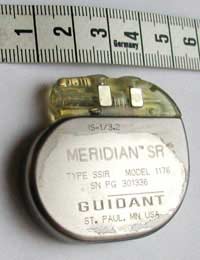How Pacemakers Work

Pacemakers are medical devices designed to help the heart beat in a normal rhythm. In a normal heart the rhythm is determined by electrical impulses triggered by the sino atrial node, found in the right atrium of the heart. When this signal becomes defective an artificial device is needed in order to keep the heart beating in a healthy and effective rhythm.
How Do They Work?
There are many different types of pacemakers, designed for individual needs of the patient. In general they can be either permanent or temporary and some work continuously, others on an ad hoc basis, as these contain a sensor and only work if the heart’s natural rhythm changes into a pattern that is not sufficient for the patient, such as a drop in regularity or change in pattern. It will take over the beat until the heart has corrected itself.Pacemakers are essentially computer based, battery operated devices that are implanted into the tissues of the patient. Once the device has been implanted, tiny wires are directed to the heart using x-ray technology. They are relatively small in comparison to original designs and will be programmed according to the patient’s needs.
Why Do I Need A Pacemaker?
Most people requiring the use of a pacemaker will need it because of an irregular heart rate. Usually this irregularity causes the heartbeat to slow or sometimes even stop, the pacemaker will prevent this occurring and keep the heart in a healthy rhythm.What to Expect
Unlike original pacemakers, modern devices can now be implanted under local anaesthetic and may take up to two hours to implant. An incision is made in the chest wall, often around the collarbone and the device is inserted. Using a-rays the wires that will conduct the electricity will be guided to the heart and the incision will be closed. Following this the computerised part of the device will be tested and programmed to the patients needs. The wound will be dressed and will be heal over time.The average life expectancy of the battery is around 7 years after which a new battery will need to be inserted. Again this will be performed under local anaesthetic.The patient and the device will need regular checks by both the doctor and a programmer. These checks are important for measuring the effectiveness of the device and to make sure the patient suffering no adverse effects.
Considerations to Remember
As the pacemaker is an electrical device, some consideration to your surroundings may be necessary. There seems to be no risk to the pacemaker or your health from the presence of almost all home appliances, but there have been reports of interferences with some types of security, telephone and surveillance equipment.Three are also many medical devices that cannot be used or should be used with caution in the presence of a pacemaker. Due to these reasons, it is recommended that an identification card or bracelet is worn, identifying the person as a pacemaker user and the type that is being used.
Pacemakers are very important and useful pieces of equipment used in the treatment of cardiac arrhythmias. They can work continuously or on demand depending on the needs of the patient.
Overall they are safe to use as long as the patient is informed of all considerations and informs the relevant people when needed.
- What Are Aldosterone Antagonists?
- Laser Surgery for Coronary Artery Disease
- Fibrinogen Treatment Before Heart Surgery
- Heart Valve Replacement Surgery
- Recovering from Heart Surgery
- Explaining Cardiac Enzymes
- Emergency First Aid for Heart Attacks
- Atherectomy and Unblocking Blood Vessels
- Thrombolysis Causes & Treatments
- Implantable Cardioverter Defibrillators (ICD)
- What are Statins?
- What is Glyceryl Trinitrate (GTN)?
- Taking Calcium-Channel Blockers
- Coronary Angioplasty Surgery
- Anti-Platelets Medications
- Long Acting Nitrates
- Heart Transplants Explained
- Using Beta-blockers
- Having a Coronary Artery Bypass


Re: Laser Surgery for Coronary Artery Disease
I was diagnosed with Idiopathic Pulmonary Fibrosis (IPF) four years ago. For over two years, I relied on…
Re: Coronary Angioplasty Surgery
My husband had a stent put in at the beginning of January. It was done at a government hospital and the doctors appointment is…
Re: Hole in the Heart: What Happens Next?
I was just in hospital with left side pain and numbness was diagnosed with hole in heart I’m home now and I’m having…
Re: Hole in the Heart: What Happens Next?
Ok I'm 61 yes old.ive been in 3 motorcycle wrecks,I have sticky platelets I've been hospitalized 3:times with blood…
Re: Why Does My Heart Beat Faster After Sweet Food?
The coffee doesn't make a heart beat faster. Caffeine makes the hart beat harder/stronger. The sugar…
Re: Hole in the Heart: What Happens Next?
Hi Doctor, My friend is having 35 years and he is having a hole in the heart, he consulted many doctors in USA and…
Re: What is Heart Block?
Hello. I have born first degree heart block. 10 years ago was temporarily changing to 2 degrees, but stay first degree. Am I at high risk…
Re: Hole in the Heart: What Happens Next?
In Sept '16 I was diagnosed with hypertension (high blood pressure) and in May '17 I had a stroke - the only symptoms…
Re: Hole in the Heart: What Happens Next?
Hi Iam 53 years old and living very healthy life. I have blood pressure but it is in normal condition with proper…
Re: What is Heart Block?
Hi there I had a pacemaker fitted last year for Mobitz II heart block. My pacemaker is set to fire if my rate drops below 60 b/pm. Am I…